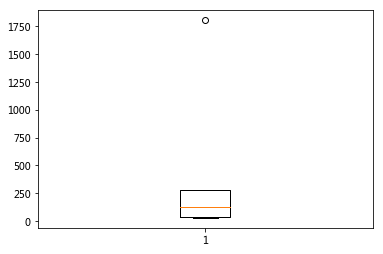在《用pandas进行数据清洗(一)(Data Analysis Pandas Data Munging/Wrangling)》中,我们介绍了数据清洗经常用到的一些pandas命令。
接下来看看这份数据的具体清洗步骤:
Transaction_ID Transaction_Date Product_ID Quantity Unit_Price Total_Price 0 1 2010-08-21 2 1 30 30 1 2 2011-05-26 4 1 40 40 2 3 2011-06-16 3 NaN 32 32 3 4 2012-08-26 2 3 55 165 4 5 2013-06-06 4 1 124 124 5 1 2010-08-21 2 1 30 30 6 7 2013-12-30 7 8 2014-04-24 2 2 NaN NaN 8 9 2015-04-24 4 3 60 1800 9 10 2016-05-08 4 4 9 36
1,查看数据的行列数:
print(transactions.shape)
(10, 6)
数据一共有10行6列。
2,查看数据的数据类型:
print(transactions.dtypes)
Transaction_ID int64
Transaction_Date datetime64[ns]
Product_ID object
Quantity object
Unit_Price object
Total_Price object
Transaction_ID列是整数,Transaction_Date列是时间序列,其余几列都是object。
3,以上两步也可以用info()命令替代:
RangeIndex: 10 entries, 0 to 9 Data columns (total 6 columns): Transaction_ID 10 non-null int64 Transaction_Date 10 non-null datetime64[ns] Product_ID 10 non-null object Quantity 9 non-null object Unit_Price 9 non-null object Total_Price 9 non-null object dtypes: datetime64[ns](1), int64(1), object(4) memory usage: 560.0+ bytes None
RangeIndex: 10 entries 表示一共有10行记录,Data columns (total 6 columns) 表示一共有6列,接下去显示的是每列非空数值的个数以及类型。
4,查看是哪几行,哪几列有缺失值,以及一共有多少行多少列有缺失值:
print("哪几行有缺失值:") print(transactions.apply(lambda x: sum(x.isnull()),axis=1))
哪几行有缺失值: 0 0 1 0 2 1 3 0 4 0 5 0 6 0 7 2 8 0 9 0
print("哪几列有缺失值:") print(transactions.apply(lambda x: sum(x.isnull()),axis=0))
哪几列有缺失值: Transaction_ID 0 Transaction_Date 0 Product_ID 0 Quantity 1 Unit_Price 1 Total_Price 1
print("一共有多少行有缺失值:") print(len(transactions.apply(lambda x: sum(x.isnull()),axis=1).nonzero()[0]))
一共有多少行有缺失值:
2
print("一共有多少列有缺失值:") print(len(transactions.apply(lambda x: sum(x.isnull()),axis=0).nonzero()[0]))
一共有多少列有缺失值:
3
需要注意的是,此数据集中有一些有空格的地方,也应视为缺失值,因此需要把空格处转换为NaN显示:
transactions=transactions.applymap(lambda x: np.NaN if str(x).isspace() else x)
现在数据集显示如下:
Transaction_ID Transaction_Date Product_ID Quantity Unit_Price \ 0 1 2010-08-21 2.0 1.0 30.0 1 2 2011-05-26 4.0 1.0 40.0 2 3 2011-06-16 3.0 NaN 32.0 3 4 2012-08-26 2.0 3.0 55.0 4 5 2013-06-06 4.0 1.0 124.0 5 1 2010-08-21 2.0 1.0 30.0 6 7 2013-12-30 NaN NaN NaN 7 8 2014-04-24 2.0 2.0 NaN 8 9 2015-04-24 4.0 3.0 60.0 9 10 2016-05-08 4.0 4.0 9.0 Total_Price 0 30.0 1 40.0 2 32.0 3 165.0 4 124.0 5 30.0 6 NaN 7 NaN 8 1800.0 9 36.0
5,去除缺失值:
transactions.dropna(inplace=True)
6,当然,我们也可以选择不去除缺失值,而是进行填充,这种方法适用于数据量少的情况下,这里选择向后填充:
transactions.fillna(method='backfill',inplace=True)
现在数据集如下:
Transaction_ID Transaction_Date Product_ID Quantity Unit_Price \ 0 1 2010-08-21 2.0 1.0 30.0 1 2 2011-05-26 4.0 1.0 40.0 2 3 2011-06-16 3.0 3.0 32.0 3 4 2012-08-26 2.0 3.0 55.0 4 5 2013-06-06 4.0 1.0 124.0 5 1 2010-08-21 2.0 1.0 30.0 6 7 2013-12-30 2.0 2.0 60.0 7 8 2014-04-24 2.0 2.0 60.0 8 9 2015-04-24 4.0 3.0 60.0 9 10 2016-05-08 4.0 4.0 9.0 Total_Price 0 30.0 1 40.0 2 32.0 3 165.0 4 124.0 5 30.0 6 1800.0 7 1800.0 8 1800.0 9 36.0
7,现在来试一下用均值填充:
transactions.fillna(transactions.mean(),inplace=True)
现在数据集如下:
Transaction_ID Transaction_Date Product_ID Quantity Unit_Price \ 0 1 2010-08-21 2.0 1.0 30.0 1 2 2011-05-26 4.0 1.0 40.0 2 3 2011-06-16 3.0 2.0 32.0 3 4 2012-08-26 2.0 3.0 55.0 4 5 2013-06-06 4.0 1.0 124.0 5 1 2010-08-21 2.0 1.0 30.0 6 7 2013-12-30 3.0 2.0 47.5 7 8 2014-04-24 2.0 2.0 47.5 8 9 2015-04-24 4.0 3.0 60.0 9 10 2016-05-08 4.0 4.0 9.0 Total_Price 0 30.000 1 40.000 2 32.000 3 165.000 4 124.000 5 30.000 6 282.125 7 282.125 8 1800.000 9 36.000
*注意:如果数据集里有异常值,应先去除异常值,再用均值填充。
8,再试一下用插值法进行填充,默认是线性插值法,适用于列数据呈线性关系的时候:
transactions.interpolate(inplace=True)
显然这里不符合要求,因此不显示更新的数据集了。仅作演示之用。
9,显示有重复值的行:
print(transactions.duplicated())
0 False 1 False 2 False 3 False 4 False 5 True 6 False 7 False 8 False 9 False
显示索引为5的这一行有重复值。
10,去除重复值:
transactions.drop_duplicates(inplace=True)
11,这里选择用均值填充缺失值,现在需要查找异常值,先用describe()方法显示数值型数据的整体情况:
print(transactions.describe())
Transaction_ID Product_ID Quantity Unit_Price Total_Price count 9.000000 9.000000 9.000000 9.000000 9.000000 mean 5.444444 3.111111 2.111111 49.444444 310.138889 std 3.205897 0.927961 1.054093 31.850672 567.993712 min 1.000000 2.000000 1.000000 9.000000 30.000000 25% 3.000000 2.000000 1.000000 32.000000 36.000000 50% 5.000000 3.000000 2.000000 47.500000 124.000000 75% 8.000000 4.000000 3.000000 55.000000 282.125000 max 10.000000 4.000000 4.000000 124.000000 1800.000000
查看Quantity, Unit_Price,Total_Price的最大最小值后发现,Quantity没什么问题,Unit_Price和Total_Price的最大值有些异常,用最大的Quantity乘以Unit_Price得到的是496,远低于1800,因此确定Total_Price有异常值。而Unit_Price的最大值不能确定有没有问题,在查看数据集后,发现没什么问题,故保留。
12,用掩码查找异常值,在数据上下限范围之外的数值即为异常值(数据上限通常是Q3+1.5*IQR,数据下限通常是Q1-1.5*IQR):
IQR=transactions.describe().loc['75%','Total_Price']-transactions.describe().loc['25%','Total_Price'] upper_extreme=transactions.describe().loc['75%','Total_Price']+1.5*IQR lower_extreme=transactions.describe().loc['25%','Total_Price']-1.5*IQR print(transactions.loc[((transactions['Total_Price']>upper_extreme) | (transactions['Total_Price']<lower_extreme))])
Transaction_ID Transaction_Date Product_ID Quantity Unit_Price \ 8 9 2015-04-24 4.0 3.0 60.0 Total_Price 8 1800.0
先计算出Total_Price的IQR,据此再计算出它的上下限,查找出有异常值的行。
13,用箱线图查找异常值:
import matplotlib.pyplot as plt fig,ax=plt.subplots() ax.boxplot(transactions['Total_Price']) plt.shaow()

显示Total_Price这一列有异常值(圆点)。
14,处理异常值,查看数据集后发现有异常值这一行是Total_Price多加了一个0,故用180替代1800:
transactions.replace(1800,180,inplace=True)
现在数据集如下:
Transaction_ID Transaction_Date Product_ID Quantity Unit_Price \ 0 1 2010-08-21 2.0 1.0 30.0 1 2 2011-05-26 4.0 1.0 40.0 2 3 2011-06-16 3.0 2.0 32.0 3 4 2012-08-26 2.0 3.0 55.0 4 5 2013-06-06 4.0 1.0 124.0 6 7 2013-12-30 3.0 2.0 47.5 7 8 2014-04-24 2.0 2.0 47.5 8 9 2015-04-24 4.0 3.0 60.0 9 10 2016-05-08 4.0 4.0 9.0 Total_Price 0 30.000 1 40.000 2 32.000 3 165.000 4 124.000 6 282.125 7 282.125 8 180.000 9 36.000
这个数据集的清洗工作到此为止,因为该数据集非常简单,因此只能用作演示。现实中的数据集要比这个复杂很多,其清洗内容还包括数据类型的转换,数据格式的转换,添加特征等等。